Anthony Metivier's Blog, page 25
June 14, 2019
3 Ways Low Student Debt Helped Me Preserve Memory In Grad School
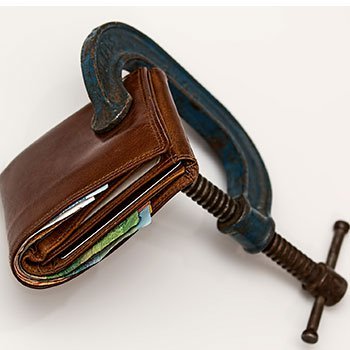 Don’t you hate that feeling every year as more fees and living expenses stack up… and it always seems like job prospects are plummeting?
Don’t you hate that feeling every year as more fees and living expenses stack up… and it always seems like job prospects are plummeting?
If you’re nodding yes, let me tell you:
I’ve been there.
I remember one day during the depths of my deepest depressions receiving an ominous letter. It said that my loans were coming due much earlier than expected.
The loan people didn’t care that I had a documented history with mental illness and even won some scholarships just for people with medical issues like mine.
They didn’t care that they were sending the letter at the worst possible time as I my exam dates were drawing ever nearer during the dark of winter.
The Debt Collectors Don’t Care About The Stress On Your Memory
And they certainly didn’t give a damn that my doctoral supervisor had recently given me a soul crushing reality-check speech. While on a walk, he told me how it was very unlikely that anyone graduating during my year was ever going get the job of their dreams.
Well, even though this letter hit me hard when I received it, I at least had one thing going for me that most of my fellow students did not. And this special strategy ensured that I had a high return on investment, even while going into debt.
Let me tell you all about it, along with a few other strategies that helped me keep my debt low that ANY student can put in place right now. I’m also including a powerful fact about student debt at the end you’re not going to want to miss.
The Tips Are For University Students, And Good
For Anyone Struggling With Debt
None of what I’m about to share with you is meant to make you think I’m an arrogant braggart.
Far from it.
I’ve just had a low tolerance for risk all my life. That’s a good thing. It’s made me productive and reduced a lot of problems. My hope is that these tips will help any student stop risking so much so you can focus on the lovely adventure of life without so much strain and pain.
Plus, I’ve made sure these tips will help anyone struggling with any kind of debt. You don’t need the stress on your memory.
The best part?
Low stress helps you preserve memory ability, the number one asset we all need to cherish and protect above anything else.
So here’s the first thing I want to share that helped keep my student debt incredibly low while making sure that my jobs weren’t a waste of time:
1. Get The Best Possible Jobs
I always worked during university, and with a few rare exceptions, I found jobs that either directly supplemented my education or kept my mind free for contemplation.

The first institute of higher learning I attended and worked at.
In this first case, I worked in three libraries:
The Okanagan University College library on the Salmon Arm campus, the Prince George Public Library and as an assistant to the head research librarian at York University.

The Prince George Public Library is a great Memory Palace and workplace.
These jobs were great for one simple reason:
In each position, I could either listen to audiobooks while replacing books and shelf-reading, or do my own research while learning from a master.
Being able to spend time on my own goals while sharpening my skills helped reduce stress as well because these roles wasted barely a minute of precious time. Nothing bugged me more then, and nothing bothers me more to this day, than frittering away time on work that builds someone else’s dreams with out also developing my own.
Were these hugely well-paying jobs? On one level, no, but every penny helped me borrow less on my student loans. And each paid off incredibly well in terms of what I learned and how I could perform double-duty.
Plus, I would always find unexpected information that accelerated learning and memory techniques helped me rapidly remember and connect with my own projects.
My Secret Strategy For Getting Expensive Books For Free
Even better, I was able to directly request these libraries order books I needed, and most of the time they would, and even speed up the process because it was an internal request. This simple benefit saved oodles of money in the long run.
Finally, library staff are usually very knowledgeable people, if not scholars themselves. That makes librarians a pleasure to be around.
Overall, these jobs were golden, so if you’ve never thought about working for either a university or public library, I highly recommend both.
The Public Film “Library” That Gave Me Heaps Of Memory Exercise
Along these lines, I also worked for the legendary Queen Video in Toronto.
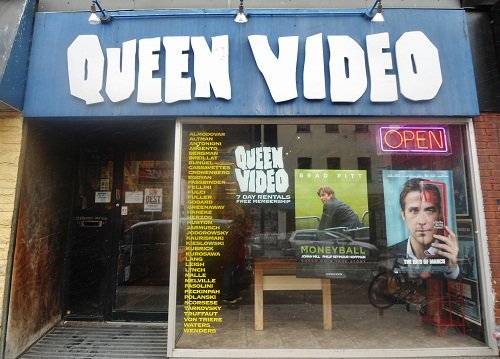
I worked at the Queen Street and Bloor Street stores. This one was my favorite.
Since Film Studies were a huge part of all my degrees, it was amazing to have direct access to what was then considered the biggest collection of VHS and DVDs in North America.
Although much busier than some of my library jobs, the endless questions about movies from the patrons kept me on my toes. Plus, the constant requests exercised my memory all day long.
And it really was all day because my shifts were from 11 a.m. to 11 p.m. with only three breaks!
The Neighborhood Debt Reducer
More grueling jobs included my own little business of mowing lawns and shoveling snow across East York, or when I worked to assist the elderly in their homes through Community Care East York.
But I kept my eyes and ears open during this time and gathered dozens of Memory Palaces.
More importantly, I heard many stories about life from the senior citizens of our neighborhood. Their autobiographies were priceless because every time I went to work, I had multi-perspectives from stories of war and economic depression that helped me remember just how good I had things, even if my clinical depression legitimately felt like the hell it was.
Personally knowing many survivors of equally, albeit differently tough times was one of the greatest medicines.
Plus, if you ever find yourself working in the homes of the elderly, you might just find yourself getting fed. I don’t have exact stats on how much money I saved during those years, but it was impossible getting out of those places without being invited to dinner or leaving with a bounty of fruit and vegetables from the gardens I helped tend.
Gardening Advantages Beyond A Quick Buck
And gardening not only reduces stress, but also gives you a skill set you can use for life. Tending tomatoes, mowing lawns and shoveling snow not only made me lots of money, but came with ample tips made from the currency of high quality homemade food. I was too stupid at the time to feed myself properly, so without these wonderful people, I probably would have died from malnutrition.
I have many more stories of the jobs I held, but in sum, if you can’t find a decent job to help keep your loans and spending down, make one.
There’s no magic to it. I just knocked on the doors in my neighborhood, the same strategy that ultimately led to me getting a major research grant after I graduated, a story for another time.
As an additional tip, you can explore the advantages of bilingualism by helping families that speak a language you’re learning. The extra exposure and practice will help your fluency and make you a more attractive candidate for hire in the future.
2. Budget and Monitor Your Expenses
Even as I was accumulating student debt that drove me bonkers with stress, I followed a budget and allocated resources for the things I needed.

For example, I couldn’t concentrate during my depressions, so I had to buy a lot of audiobooks.
Back then there was no such thing as Audible, the library wasn’t able to get some of the exact programs I wanted, and in this case, there were crazy amounts of shipping.
But because I budgeted for learning materials, I was able to get what I needed and then sometimes resell the programs after siphoning the information into my mind.
I could do this because, except for wasting too much money on the booze I used to self-medicate my depression (never realizing it was actually worsening it), I walked or rode my bike everywhere I could.
Also, I figured out a few ways to reduce the trips I needed to take to campus. For example, a few times I arranged to be write additional research papers in lieu of attendance grades.
One course in particular had 20% of the grade weighted just on showing up.
How Negotiating Better Class Attendance Saves Cash On Commuting
I told the professor I loved him and loved attending his course, but really needed an alternative arrangement. We agreed upon the length and depth of the additional work I would do, and bang presto, I completed the entire course without having to travel to the campus again from that day on.
And he really had no hard feelings. In fact, years later, he wound up sitting on my dissertation defense committee. This arrangement saved not only time, but also the transit fees.
The Zen Of Walking And Biking Towards Knowledge
Likewise, I took two directed reading courses in grad school.
In both cases, I arranged to meet the professors in cafes I could reach by bike or foot. On the one hand, a directed reading course can be more intense and feel like more work.
To be honest, it also lays more scrutiny on the work you produce because the professor isn’t forced to split attention to other students. But this is ultimately a good thing because it sharpens you for the career yet to come.
Saving Tips From An Academic Monagamist
Also, this next one might seem like a weird tip, but I found it useful for many reasons:
Have a steady romantic partner and treat it like a marriage.
All throughout university, I saw people driving themselves crazy with romantic pursuits instead of focusing on their studies.

Enjoying an inexpensive and soulful date in an amazing cafe that is also a powerful Memory Palace.
Look, I’m flesh and blood too, but dating is not only financially draining, but the many emotions drain energy too.
So I gave up the endless chase of the dating buffet for the less exotic, but ultimately more satisfying long-term game, even if I knew these relationships would ultimately not last.
I’m not really the best person to be giving relationship advice. But when it comes to everything that went into getting my PhD, purely through the observation of others (many of whom never made it to the finish line), I really do feel I spared myself a lot of drama and expense.
I circumvented a ton of pain by cultivating long-term romances, keeping them deep, but simple. And since they were usually with other university students, they were largely intellectual. Other than books and beverages, talking philosophy for hours on end is free and easy review and hardly costs a thing.
3. Use Memory Techniques
The beauty of using memory techniques effectively and well is that you never fail exams. Absolute success means you never have to take courses over again or stack on additional years to complete your degree.
I saw many people fail courses and extend their stay at university, which ultimately stacks on more debt. The sooner and more directly you graduate, the less your education costs.
My first and second Master degrees, for example, were both two year programs and in each case, I completed them in just one, saving significant fees.
I also completed my PhD program ahead of and was even found eligible to pause the fees for an entire year while I waited for the dissertation defense committee to find a date for the great intellectual grilling.
This pause in paying tuition helped me leave Toronto, live in Manhattan and I even found a teaching gig over in New Jersey (at Rutgers) during this time.
In other words, you not only save tons of time you can direct at other activities when you can learn faster and remember more.
You can also find other jobs that pave the path to a better future. For example, it helped a lot that I had Rutgers on my CV and a great reference when I knocked on the door of a director’s office in Germany. But if I’d been learning like a slow-poke, I wouldn’t have had the time to accumulate more practical experience in my field.
So if you need to know how I memorized so much info so quickly, get started now:
You’ll love how it helps you strategize a full Memory Palace Network you can use to gobble down knowledge and keep it in your brain for when you need it.
About that fact I mentioned at the beginning, there is an interesting study showing that student loan debt is negatively influencing how often people get married.
This research suggests that if you want to have a better marriage, or even get married at all, keep your debt as low as possible. Student debt may also cause people to have fewer kids too, so keep that in mind if you dream about having a family one day.
Next, I suggest you watch these videos, hit the thumbs up, get subscribed if you aren’t already and keep the conversation going below. Thanks as always for the view, and until next time, keep yourself Magnetic!
The post 3 Ways Low Student Debt Helped Me Preserve Memory In Grad School appeared first on Magnetic Memory Method - How to Memorize With A Memory Palace.
June 5, 2019
3 Blazing Fast Ways To Increase Memory Retention
 Memory retention… what the heck is it? Is it worth worrying about? If so, can it be improved?
Memory retention… what the heck is it? Is it worth worrying about? If so, can it be improved?
We’re going to cover memory retention on this page and give you three blazing fast ways you can increase your ability to retain information.
The Simplest Definition Of Memory Retention
Overall, this term from the world of memory science is simply defined:
It is the ability to keep any information for different periods of time for the purpose of using it in the future.
And so if someone gives you their name, but you can’t , you haven’t retained it.
Why exactly we retain some things and not others is the subject for another post, but basically, we don’t really need a more robust definition for memory training purposes.
Nonetheless, you might be wondering about the differences between short term memory and long term memory when it comes to memory retention.
You might even be wondering about how working memory plays into the mix when it comes to learning faster and remembering more.
These are all great questions that we’ll be covering in the future, so make sure you have this so you’ll be notified:
Now, another question people ask is…
Why Is Memory Retention Important?
In addition to practical matters like remembering names, passing exams and learning new languages, memory retention helps you connect with yourself.
Think about it:
Every time you can’t recall information about your own life… it feels kind of weird, if not outright painful.
Self-punishment ensues and usually that only exacerbates the memory problems you might be facing.
So with an eye to helping you feel more connected with yourself, let’s dive into three rapid ways you can increase memory retention.

1. Take Better Care Of Your Brain
Look, I know everyone wants memory techniques that are easy and fun to use.
However, it only makes sense to care for the engine that makes memory possible in the first place.
For example, many people who complain of brain fog don’t need memory techniques on their own. They simply aren’t eating well.
Although diet is a tricky matter, you’ll find certain foods help improve memory better than others.
Diet has been a huge problem for me throughout my life, but I’ve one a lot to fix it and experienced much better memory as a result.
In my case, chronic pain has been the most mentally taxing and distracting problem.
Pain makes paying attention difficult.
When you can’t pay attention to information, memory retention goes out the window.
Reduce the pain, and your ability to pay attention and retain information in memory automatically goes up.
(And no, in case you’re wondering, these memory improvement vitamins are unlikely to help.)
Sleep Secrets for Better Memory Few People Consider
Next, we have sleep.
Although you might not normally think of it this way, not having enough sleep also creates pain the interrupts the ability to pay attention.
Being groggy and irritated, for example, is a kind of pain.
Plus, the brain simply cannot perform as well unrested as it can when you’re getting enough sleep.
What are the secrets?
Computer curfew
Journaling by hand, including gratitude journaling
Planning the next day’s activities
Bedtime rituals
Morning memory fitness activities, such as dream recall
Just by attending to diet and sleep (and stopping smoking), you can improve your memory retention, and it will happen faster than you might think.
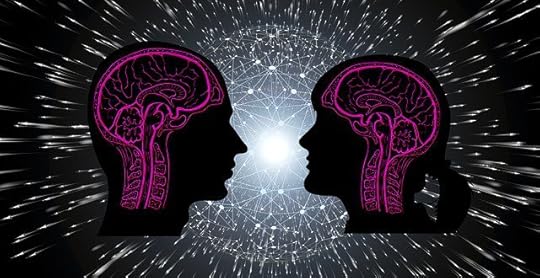
2. Get Regular Memory Exercise
One of the easiest ways to improve memory retention is to regularly use your memory.
There are at least two kinds of memory exercise:
Active and passive.
I’ve got a wide variety of brain exercises you can play with, and here’s a condensed version of my favorite from the passive category.
It’s called The Four Details Exercise. All you do is notice 4 details about a person.
Don’t use any memory techniques. Just observe.
Later in the day, ask yourself to recall those details.
No Need To Give Yourself A Grade
It’s not a right or wrong memory retention test. It’s just a quick jog to make sure that you’re giving your memory regular exercise.
Active memory exercises for increasing retention might include using memory techniques. Here’s where “right and wrong” comes into play, and that’s all part of the fun.
For example, you can memorize a deck of cards and work on increasing either your speed of encoding, or the volume you can encode. Test yourself for accuracy of retention over different stretches of time (5 minutes, 5 hours, 5 days, etc).
You can increase speed and volume with names, vocabulary, abstract shapes, numbers and even verbatim texts like song lyrics or poems.
Likewise, you can actively memorize vocabulary, historical dates, or the names of everyone in a company you want to work for (or already do).

3. Have A Long Term Learning Project
Okay, I know this doesn’t sound like a “blazing fast” tactic. But in reality, it is.
Here’s why:
Learning a language or memorizing large texts that you focus on over the long term produces incredible short term benefits when it comes to memory retention.
Improvements will happen for you because, as you use memory techniques consistently, you’ll build up something called “memory reserve.”
This term means that the more you know, the more you can know.
Why You Should Learn A Language To Increase Your Ability To Retain Information
Take language learning, for example.
As soon as you know about 850 words, you have all the building blocks you need to snap on more and more vocabulary and phrases.
Each new word and phrase you add builds up your memory reserve.
And this memory reserve helps explain why many people find it easier to pick up their next language. They’ve become good at the skill of building their memory reserve.
When it comes to memorizing large texts, I’ve been doing this with some scriptures written in Sanskrit.
The more I memorize, the easier it becomes to memorize even more due to this effect of memory reserve.
For example, the pool of Magnetic Imagery grows. Having more to draw upon means fewer Magnetic Images are fired off with less effort.
You’ll find this is also true when memorizing texts in your mother tongue. The more you do it, the greater ease with which you can move through words, expressions, ideas and more.
And again, you don’t have to wait forever for the memory retention benefits to kick in.
How To Start Investing In Your Brain (And Keep Consistent)
Just get started.
I know that sounds simplistic, but how else would you do it?
Next, be consistent. That means showing up at least a little.
Ideally, you’ll train your brain every day, but four times a week is a bare minimum.
Before you know it, you’ll feel like you have a completely revived brain that can conquer the world of information overwhelm with ease.
Again, we’ll talk in the future more about things like short term, long term and working memory, but the reality is that all these aspects of memory work together.
By following the 3 simple tips in the following video companion to this post, you’ll be working them comprehensively, holistically, and, dare I say, Magnetically.
The post 3 Blazing Fast Ways To Increase Memory Retention appeared first on Magnetic Memory Method - How to Memorize With A Memory Palace.
May 29, 2019
Bilingualism Advantages That Fortify Your Brain With Bartosz Czekala

Are you struggling to understand all of the bilingualism advantages people keep talking about?
Are you jealous of people already learning their third (or even fourth) language? Does bilingualism seem like something that’s simply out of reach? Do you feel as if you’re being held back by some invisible force to meet your goals in language learning?
Oftentimes we are crippled by our misconceptions of learning another language.
Worse, a lot of people don’t know just how beneficial bilingualism is for the human brain.
As a result, people blindly believe they’re just not smart enough.
Worse, they think that mass marketed learning methods “won’t,” or “don’t” work. That’s a big problem, especially if we’ve hit a wall with our learning journey. We tend to blame the techniques without looking at our strategies for using them.
The Biggest Problems Language Learners Face
We may falsely believe we just don’t have the time to dedicate to learning a language, “It’s too late to start,” or we know we’ll never have the opportunity for immersion learning, so we simply give up.
My guest today on Magnetic Memory Method Podcast is Bartosz Czekala from Universe of Memory.
As a multi-linguist, language teacher, and someone with a background in computer science, econometrics, and legal translation, Bartosz is also strikes me as world class mnemonist. With Polish as his native language, he learned Swedish in only four months, and speaks seven additional languages.
The Ultimate Bilingualism Advantages Await
To share his knowledge, Bartosz’ website pairs memory techniques with learning systems to help you master language learning in fun and creative ways.
Today we run the gamut of the journey of learning another language, from common barrier to success to the methods for guaranteed results and the pros and cons of various learning techniques. We explore the relationship of memory to language studies and the science behind it all.
If you’re looking for a real, unfiltered conversation about language learning, struggling to come to terms with “Is it for me?” this is the podcast for you.
In sum: it is possible to learn a foreign language. You just need to equip yourself with the right tools.
Just press play now to learn about:
The effect of diet and sleep on memory, specifically fasting and sleep deprivation
The correlation between focus and concentration and eating habits
The impact of the sun on overall mental health
How results are possible with every memory method, but not always optimal
The impracticality of apps for language learning
The biggest issues with textbooks and word frequency
The argument for spaced repetition and its usage for learning another language
The importance of being a “scientist” in your own mind
The benefits of context and meaning to learning foreign language vocabulary
Passive exposure versus active learning
How knowing multiple languages fortifies the health of your brain’s neural networks, lessen the forgetting curve, and maybe even give you an incredible career
Pros and cons of immersion and proxemics for language learning
The differences in language learning in adolescence versus adulthood
Further Resources on the Web, This Podcast, and the MMM Blog:
Bartosz’s Universe of Memory
How to Learn Faster and Rediscover the Joy of Learning
The Science of Language Learning: How Learning a Language Affects Us
How to Learn and Memorize the Vocabulary of Any Language
The Freedom Journal For Language Learning
Teach Yourself (MMM Podcast Interview with Olly Richards)
Stoic Secrets for Using Memory Techniques with Language Learning
The post Bilingualism Advantages That Fortify Your Brain With Bartosz Czekala appeared first on Magnetic Memory Method - How to Memorize With A Memory Palace.
May 22, 2019
Surviving PTSD With The Help of Memory Techniques Featuring Nicholas Castle
 Have you ever experienced trauma in your life that created mental blocks, or worse, PTSD?
Have you ever experienced trauma in your life that created mental blocks, or worse, PTSD?
Or do everyday situations remind you of terrible experiences from your past?
I know I am not alone when I say that there are painful memories that can be haunting.
From the death of a loved one, to near-death experiences and childhood trauma, we all have that “thing” that pops up from time to time and haunts us …
If we let it.
But here’s the powerful truth:
We don’t have to live our lives in a constant state of fear that these memories will be triggered.
Although we can’t prevent memories from flooding back at inopportune times, we can change how we respond to our triggers.
A Powerful PTSD Survival Story
To help those suffering from any kind of unwanted memories flooding their awareness, here’s what I’ve done:
On this episode of the Magnetic Memory Method Podcast, I sit down with the founder of Bushcraft for Kids, Nicholas Castle.
His organization teaches children survival and outdoors skills to increase their self-motivation, life skills, and confidence through adventure.
Using these same memory techniques he teaches to his students, he explains his journey from being a young boy struggling with dyslexia to a former law enforcement officer living with post-traumatic stress disorder.
His secret to overcoming these setbacks?
The thing that struck me most about our conversation was how versatile Memory Palaces became for Nicholas.
Not only was spatial memory and mnemonics essential to his success in his educational career, but also throughout his time in law enforcement. This role included public speaking, a healthy, but still stressful situation he had to deal with on top of his PTSD.
And you know what?

Nicholas enjoying a forest that also serves as a Memory Palace
Memory techniques saved the day yet again. A bit of time out in nature helping other people seems to have contributed to Nicholas’ success too.
If you want to know how Memory Palaces can help to transform every facet of your life, especially if you are dealing with the symptoms of post-traumatic stress disorder, like Nicholas, this episode of the Magnetic Memory Method Podcast is for you.
Press play above and discover:
How creating memory palaces can improve confusion from dyslexia (a condition that didn’t stop Dominic O’Brien from creating the Dominic System)
An important point about the logic behind creating Memory Palaces (including prompts for and how to create them)
The relationship between magic and memory through association
Notes on the influence of Tony Buzan and Harry Lorayne
How mnemonics can improve public speaking
The precise way memory techniques reduce the stress responsible for so much memory loss
How using memory techniques can help to influence large groups of people
Commonalities between hypnosis and mnemonics
The potential of memory techniques to manage PTSD symptoms
The versatility of meditation practice for concentration
How to use a Memory Palace Network as a practical learning tool
Further Resources on the Web, This Podcast, and the MMM Blog:
Nicholas Castle’s organization, Bushcraft For Kids
How to Improve Memory Power and Concentration by Eliminating Stress
Memory Techniques and Dyslexia
Post-traumatic Stress Disorder
Test for Dyslexia: 37 Common Traits
How to Practice Memory Techniques For Studying Tough Subjects
The post Surviving PTSD With The Help of Memory Techniques Featuring Nicholas Castle appeared first on Magnetic Memory Method - How to Memorize With A Memory Palace.
May 16, 2019
4 Powerful Ways to Use the Pegword Method [10 Examples Included]
 The pegword method is a simple memory technique for remembering lists of information.
The pegword method is a simple memory technique for remembering lists of information.
I’m talking about lists filled with:
Vocabulary
Study keywords
Names (people, countries, foods)
To-do list items
Historical dates
Medical or legal terminology
Computer programming documentation
… and anything that can be organized into a list
There are a few variations to this technique. We’ll discuss 4 of them on this page.
But first, this is important:
Each pegword system involves three easy stages:
1) Setting up and remembering the system
2) Encoding new information with the system
3) Recalling the information by triggering the system
In the first stage, people learn a standard set of peg words. These “pegs” can be number-rhyme pairs or letters of the alphabet.
The Many Types of Peg System
There are different types of peg systems you can choose from. All of them use the same method: the use of a concrete object to represent each number. What’s different is how you choose the object.
We can divide these approaches into the following categories:
The rhyming method
The meaning method
The alphabet method
The look-alike method
Let’s talk about the rhyming pegs first:
1. The Number Rhyme System
Some people call this approach “the One is a Gun” technique. Many people using this approach have a pre-memorized list like this:
One is a gun
Two is a shoe
Three is a bee
Four is a door
Five is a hive
Six is drum sticks
Seven is Evan
Eight is a gate
Nine is wine
Ten is a hen
As you can see, when using the rhyming method, you create pegs that rhyme with a number to create a pre-memorized list.
In the next stage, memorizers visualize the information they want to remember and mentally link it with the rhyming word.
A High Precision Tutorial On How To Make The Links
Ideally, you don’t make your associations in the void of your mind.
Instead, I suggest you create them in a well-formed Memory Palace.
For example, if you have previously committed “two is a shoe” to memory, you can set a rule that every Magnetic Station in a Memory Palace features that shoe.
Then, when you meet a group of people and the second person tells you her name is Rose, you can instantly see a rose growing out of the shoe.

Mnemonic Example of using the pegword method to memorize the name Rose
Of course, Rose gets special treatment in your Memory Palace after you’ve shot Paul McCartney in the chest on the first station of your Memory Palace.
This will help you remember that someone new goes by the name Paul. On station three, you use the its peg to interact with an image for the next name, and so forth. This scenario is just one example, and very powerful when or other events.
Powerful, isn‘t it?
It gets even better if you’re interested in number systems, but for now, let’s press on.
The Scientific Term For This Kind Of Mnemonic
Some researchers of memory and learning call the product of linking one word to another a composite image or picture.
In today’s example with Rose, I have brought together the peg, the given name and a part of a Memory Palace.
This process creates a singular, mental image that is easy to recall later – especially because I naturally made the image strange, vibrant and drew upon all the Magnetic Modes while creating it.
To put the process more simply, information like Rose‘s name gets ‘pegged’ to certain images. And as you‘ve seen, my preference is to also “peg” information to a Memory Palace at the same time. Everything is co-created in one fell swoop, as much as possible.
Why There’s No Need To Follow The Order
Here’s a very cool feature of this technique:
It is not dependent on retrieving the items you memorized in sequence.
For example, if you want Rose, you don’t have to start with the first piece of information and work your way through the whole sequence. You can access her name or any item on the list simply by thinking of the number rhyme.
To achieve this flexibility, initially, all you have to do is to prepare a list of peg words that can be easily retrieved and link them with other items.
How To Memorize Your Pegs
If you’re using the number-rhyme system, it‘s really quite easy. Rhyming does most of the work.
As a pro tip, always make each object specific.
For example, I don‘t use an abstract gun, but a very specific gun from the movie Videodrome.

A gun from David Cronenberg’s Videodrome. It’s exactly the kind of strange imagery that makes memory techniques work so well.
For 2, I don’t use just any old shoe. I use my favorite shoes from when I was a kid. (They had velcro pockets for holding coins.)

My friend Evan
In each case, try to make each rhyme you choose concrete and specific. For 3 is a bee, I use Jerry Seinfeld from The Bee Movie. For 7, I use my friend Evan instead of something abstract like heaven.
It might take you a few minutes, or even a few hours over a weekend to land on the most specific option possible. It will be worth the effort!
If you’re struggling, you can adopt the Mind Mapping examples here for creating your imagery too. There’s always a way!
How To Mix Your Pegs With The Major System
This method is useful for many things beyond remembering names, shopping lists and errands on your to-do list.
You can use it for remembering new concepts, foreign language vocabulary, ideas, dates, potentially for verse numbers and anything you organize in a linear manner, but that doesn’t necessarily require linear recall.
To remember a date like 1789, you use would use the Major Method or the Dominic System to create images for these numbers.
Then you would link the images to one of your pegs. If assigned to your sixth peg and you are using drum sticks, you might have Tucker Max (17) pounding on a viper (89) with the drum sticks.

Mnemonic Example with Tucker Max and the Green Day Drummer drumming on Cobra Commander
Because I focus on specificity, it’s not just any drum sticks, but the sticks used by the Green Day drummer. It’s not just any viper, but Cobra Commander from GI Joe.
I‘m giving you my specific mnemonic examples for a simple reason:
Making the images concrete and based on real things that have been interesting or important to me in life is part of what helps the memory techniques work better and faster.
You might never have heard of Green Day or played with GI Joe toys. But surely there is a drummer you find interesting and an appropriate image you can use for each of the digits from 00 to 99.
It’s really not rocket science. It just takes a small amount of focus and time after completing a memory course.
2. The Meaning Method
In the meaning method, you create pegs that help you recall the sound and meaning of the words you want to recall later.
For example, to remember the word ‘exploration’ with the rhyming pair (one is a gun), you can visualize ex-cops with guns patrolling an area where oil exploration is taking place.
Take the word “quadrangle,” to give you an additional example.
The most immediate and obvious association is a quad bike. Since a quadrangle has four sides and a quad bike has four wheels, it generally works to cover both sound and meaning.
This approach becomes incredibly streamlined the more you practice. It’s great for language learning, medicine, law, philosophy and any learning area rich with semantic meaning. This method is best used with a Memory Palace.
There is another type of widely used peg system. It uses alphabet letters as pegs.
Let’s check it out:
3. The Alphabet Peg System
Although this technique is essentially a variation on the Number/Rhyme method, it gives you more pegs. You can use it to remember longer lists of items in a specific order.
True, it takes more time to learn than a number-based technique, but rest assured that some people love this approach so much, they have multiple alphabet lists. And having more than one list is one of the core teachings in M.A. Kohain’s underground memory improvement book, Mnemotechnics: The Art and Science of Memory Techniques.
How to Use the Alphabet Method
In this technique, you will associate objects or people based on each letter of the alphabet. Later, you will link these alphabet associations with information you want to memorize.
Please note how I am applying the rule of specificity to each of these examples:
A – Apple laptop (the one I‘m typing this article on)
B – Batman (Michael Keaton version)
C – Chocolate (My favorite kind)
D – Dracula (As played by Bela Lugosi)
E – Elephant (Edgar, who you may have seen on my YouTube channel)
F – Fish (I use Kami the fish)

Kami the Fish, one-time mascot of Kamloops, B.C., Canada
G – Goat (I think of The Jesus Lizard album by this name)
H – House (The movie by this name and its poster)
I – Igloo (specifically the one Pingu built)
J – Jelly (as in the band, Green Jelly)
K – Kangaroo (Hippety Hopper from the Warner Bros. cartoons)
L – Lantern (from Green Lantern)
M – Mouse (Mickey Mouse)
N – Nose (as seen on Michelangelo‘s David)
O – Orange (A Clockwork Orange)
P – Pan (Peter Pan)
Q – Queen (The rock band)
R – Rat (Splinter from Ninja Turtles)
S – Shore (as in Pauley Shore)
T – Turkey (the country on a map)
U – Umbrella (in the hands of Chauncey Gardiner)
V – Van (the one from A-Team)
W – Wagon (Stagecoach, starring John Wayne)
X – Xylophone (I loved the one I had as a kid)
Y – Yarn (my mom knits)
Z – Zed (from Pulp Fiction)
Once you have associated your images with the letters, you will then peg them to the items you wish to remember. Suppose you have to remember the following list of 10 gift items.
A watch
A DVD of the TV show “Friends”
Camera
A shoulder bag
A scarf
Perfume
A tennis racket
A pen
A tea set
A dress
Next, you will mentally link these items with the images that represent the letters of the alphabet. I suggest you follow the order of letters. For example, the numeric equivalent of the alphabet, a, is 1; b is 2; c is 3, and so on.
Read the list and link them with the images described above, ideally in a Memory Palace. Notice how I am making each example dramatic, dynamic and either exaggerate through action or strange.
10 Mnemonic Examples For The Alphabet System
A – Apple laptop: A watch: Think of Steve Jobs smashing your favorite watch (or a very expensive one) with a laptop.
B – Batman: Imagine this iconic superhero using A DVD of the TV show “Friends” as a replacement weapon to his Batarang.
C – Chocolate: Camera: Human-shaped chocolates are dancing seductively during a photo shoot. The camera nearly melts because it‘s so shy.
D – Dracula: A shoulder bag: Dracula tries to suck blood from a shoulder bag.
E – Elephant: A scarf: An elephant chewing on a scarf as if it were hay.
F – Fish: Perfume: The fish is using the perfume like pepper spray to keep a shark away.
G – Goat: A tennis racket: The Jesus Lizard album “Goat” enters a tennis court and interrupts the game. The tennis racket tries to scare it away by blasting it with music.
H – House: A pen: You use a pen to sign the lease to your dream house… Except it‘s a haunted hose and eats the pen!
I – Igloo: A tea set: You are enjoying a cup of warm tea with your family inside an igloo as Pingu crashes into it.
J – (Green Jelly): A dress: The singer of this band spoils a dress you are about to buy by spreading it with a huge jelly stain.
Recalling the items is easy.
Just bring back the image you associated with each letter. With a bit of practice, you will become a pro.
Remember: You always have multiple chances to recall the target information:
1) You have both image you associated with the letter of the alphabet
2) You have the image for the letter of the alphabet
3) You have the interaction between the two taking place in a Memory Palace
4. The Look-Alike Method
Now, before we conclude, you might be wondering…
Where the heck does this clever memory technique come from?
The Number Shape Peg System
(Origins of the Pegword Method?)
Some people attribute the first peg system to Henry Herdson. He wrote instructions on mnemonics and memory back in the mid-1600s. In Ars Memoriae (1651), Herdson suggested linking each digit from 0-9 with an object that resembles the number.
Examples Of The Number Shape Peg System
For example:
1 = candle

Mnemonic Example of a number shape for 1
2 = duck
3 = mustache
4 = sailboat, and so on.
Herdson’s images don’t sound very specific.
But even if Herdson didn’t use the Magnetic Memory Method, I suggest that you do.
For example, I think of a candle I had burning when I nearly accidentally burned down the house. This specificity makes everything stronger when I use the candle to memorize numbers.
You can find more number image examples in the Magnetic Memory Method Course How to Memorize Math, Numbers, Simple Arithmetic and Equations.
And if you feel like you don’t remember enough of your life to make each image specific enough, try these autobiographical memory exercises:
How Will You Use The Pegword Method?
As you can see, there are a lot of ways you can make pegs. You could use your favorite superheroes and then turn their bodies into Memory Palaces.
For example, Batman could be segmented into his head, shoulders, arms and legs.
There’s no end to the pegs you can create. And never forget:
Every peg can be combined with a Memory Palace for maximum effect.
So what do you say? Are you ready to create some pegs and memorize information?
The post 4 Powerful Ways to Use the Pegword Method [10 Examples Included] appeared first on Magnetic Memory Method - How to Memorize With A Memory Palace.
May 9, 2019
Improve Short Term Memory: 7 Easy Steps To Better Memory For Life
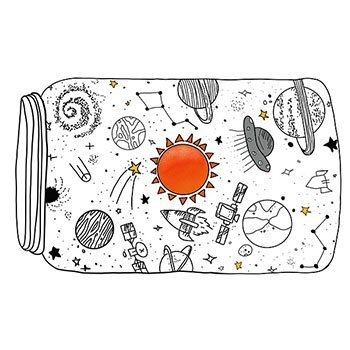 Even if it feels like trying to capture the entire cosmos in a jar, it’s actually pretty easy to improve short term memory.
Even if it feels like trying to capture the entire cosmos in a jar, it’s actually pretty easy to improve short term memory.
Would you like that?
If so, that’s what you’ll learn to do on this page. Read every word for the facts and some simple memory exercises that will help you improve your overall memory quickly.
But first, we need to establish the nature of this unique memory problem.
What exactly does a problem with short-term memory look like?
A Shocking Portrait Of Short-Term Memory Loss
Imagine the following scenario, inspired by the true-to-life novel about early onset dementia, Still Alice:
You’re in the kitchen, preheating the oven to make a batch of your world-famous brownies. You’ve assembled your ingredients on the counter to prepare your batter… and then the unthinkable happens. You only have one egg left in the carton and the recipe calls for two.

At least… that’s how you remember it.
Frustrated, you grab your keys and head to the store. You remember you’re low on paper towels and need batteries for the TV remote, so you put those in your cart as you navigate the aisles. (Perfect opportunity to create a Memory Palace, isn’t it?)
You pay for your items, load up the car, and drive home. You walk back into the kitchen and feel happy when you see that the oven’s temperature ready for your brownies. And then you realize you forgot the eggs you went to the store for in the first place!
It happens to the best of us. Our short-term memory can be seriously lacking at times. Stress, depression, lifestyle habits like sleep, diet, and exercise, even medications, can cause short-term memory difficulties.
So what do we do? Do we resign ourselves to list-making and app dependency to remember daily bits of information? Are we glued to the smartphone or pen and paper as our lifeline against forgetfulness?
Don’t lose hope. There is a better way. I’ve assembled a step-by-step guide that can help you improve your short-term memory so your next baking session goes off without a hitch.
Keep reading to discover: an actual means of improving short-term memory and examples of short-term memory at work.
A Brief Definition Of Short Term Memory
While we could dive straight into the techniques of improving memory so as to not risk getting bogged down by terminology, it’s important to first define what short-term memory actually is.
We must first note that there is a difference between short, long term, and working memory. And it’s important to note the different memory problems that emerge from each.
While long term and working memory are more complex, short-term memory is simpler, with a two-fold function.
Short term memory is:
An ability to understand sentences, spoken and written. It is, at its most basic, tied closely to comprehension.
The ability to remember small sequences of numbers, such as telephone numbers.
Short-term memory is the type of memory that helps you understand what you are reading.
Without it, you‘d be constantly confused when studying, saying “What did I just read?”
It is also the type of memory that when you see an infomercial on television lets you remember the telephone number to call and order your Flex-Seal or airbrush makeup kit for only three easy payments of $19.95.
The Zen of Improving Short Term Memory
Because memory is so central to our overall brain function, to improve it, we must improve all of our types of memory.
This means tapping into:
Episodic memory
Figural memory
Procedural memory
Semantic memory
Spatial memory and even autobiographical memory. Like this:
The name of the game is comprehensive improvement. Isn’t that what we really desire anyway?
If not, we should.
Why?
Because when we focus on a complete enhancement of all aspects of our memory we will do more than improve our short-term function. We will also transcend the textbook definitions of memory.
And it feels like “Zen” because, once you’re into the rhythm of working on your memory, you’ll wonder why you never did it before. It’s so much fun!
How Anyone Can Hold Far More Than 5-8 Digits In Memory With Ease
We need to look no further than memory competitors who blur the lines of what short-term memory is defined as. The textbook definition suggests one can only keep five to eight digits in memory at once.
Yet, using a simple number system, World Memory Champions like Alex Mullen can memorize a deck of cards in seconds. Although he doesn’t use the Dominic System, I imagine Alex learned a lot from that approach, as can we all.

Memory athlete Alex Mullen
Now, you might be looking at the photo above and thinking… Alex is so young!
You’re right, but check out Lynne Kelly who wrote The Memory Code. She’s one of many mature members of our society who do very well in memory competition.

Lynne Kelly, author of The Memory Code
Plus, please understand this important point:
This practice is not just about playing cards and numbers.
When I‘ve given memory demonstrations, I have memorized 20 to 30 names in only the amount of time it took to hear them.
Thus, the boundaries of what short-term memory is called in textbooks is not so strict, so rigid or so limited.
Now that you know that these memory feats come from specific kinds of brain training, it‘s worth repeating this simple fact:
You need a holistic, comprehensive memory training program, ideally one that leads to long-term memory benefits that offer you predictable recall.
How Comprehensive Memory Training Helps (Quickly)
In order to give you long term, predictable recall, the first step is to exercise your spatial memory.
This is where the Magnetic Memory Method and using a robust Memory Palace Network comes into play:
Next, we have elaborative encoding, which I call Magnetic Imagery (sometimes called mnemonic imagery). This mnemonic skill must be sharpened.
How do we become great at creating associations so we can remember more?
There’s no shortcut or quick-fix here. Daily, creative repetition is the key to building a strong foundation on which to build your short-term memory comprehensively.
If you take the time to create your Memory Palaces, then encode them with real and relevant information that is important to your life, you will be far ahead of the game.
Next, practice decoding, or Recall Rehearsal. Used inside a Memory Palace for a meaningful learning project, your short-term memory will be sharpened, improved and ready for use at the drop of a hat.
Step One:
Eliminate The Digital Brain Games
Can apps help improve your memory?
The short answer:
It‘s unlikely.
The longer answer:
Relegating your memory improvement to a device is only marginally beneficial. One of the former leading memory improvement software companies, Cogmed, promised big results with completion of problem-solving and training tasks.
Although some improvement occurred, there was no evidence these results were lasting. In this digital age there is still the need for real, human interaction. In other words, personal, one-on-one training, not artificial intelligence or a simulation, for real, durable results.
This is true for language learning as well. Sure, you may find that you can remember a list of vocabulary or read fluently in a second language with learning software, but true results and comprehensive fluency include conversation. This cannot be accomplished with software alone.
The general rule is to get off apps, not more into them. We are almost glued to our smartphones, immersed in virtual reality, out of touch with the real world. Why add one more notification or thing to be tended to for the computer in our pocket?
Turn off the TV and write a story. Don’t see yourself as an author? …Just try. Put pen to paper and don’t be afraid to suck.
By simply writing a short narrative, you will manage character names, locations and other details in your short-term memory. It’s very powerful.
Step Two:
Keep A Snapshot Journal
Do you remember the rant from Foo Fighters frontman Dave Grohl?
“Musicians should go to a yard sale and buy an old … drum set and get in their garage and… just suck. And get their friends to come in and they’ll suck, too. And then they’ll …. start playing and they’ll have the best times they’ve ever had in their lives and then all of a sudden they’ll become Nirvana.”
Great advice, but get this:
You don’t have to be a virtuoso to be a musician and benefit from mnemonics for music.
Likewise, you don’t have to be an author to write. When it comes to memory, all you have to do is record the things you enjoy about your life.

The Snapshot Journal I’m using
I’ve recently taken up using a Snapshot Journal, which lets you compare five years in the same diary on a single page.
Since writing is known to improve memory and I love the simple passive memory exercise of remembering a few things from the day before, I snapped one up and have used it daily ever since. It makes a difference.
As a tip, keep your Snapshot Journal open and in a high traffic part of your home. I keep mine by my desk and use it to list movies I‘ve seen, the livestreams I‘ve held and my accuracy with memorizing cards.
Flip back through the pages regularly and see if you can think of things to add.
Again, this is comprehensive memory training. It might not see to relate to short term memory, but by focusing in the present moment deep into your past memory, you are practicing the practice of linking focus and concentration together.
Like writing a bit of fiction, writing about your own life is one of the best and fastest ways to start remembering more in the short term. It improves this aspect of your memory for a simple reason:
Because it’s using it.
Step Three:
Read Daily From Print For Better Memory
Speaking of writing, reading is a great memory exercise.

Walking and reading in Denmark
You retain your focus to comprehend what you’re reading. If you lose the details of what you just read, or you’re constantly having to go back and reread a few paragraphs, don’t fret or turn it into a problem. Simply read again with more purpose and intention. Over time, you can improve your short-term memory by focusing in this way.
And when you find your mind wandering, go with it! Instead of beating yourself up about it, go for a walk and pay attention to the world, untethered from all devices. Simply notice the world and the details of nature. 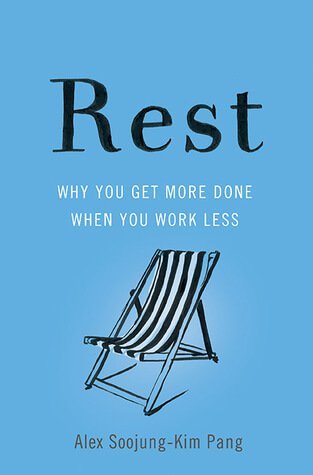
This suggestion is just one of the many Alex Pang makes in Rest: Why You Get More Done When You Work Less.
If you don‘t like to think of walking as a positive mind wandering generator, incorporate Recall Rehearsal into the journey. Take advantage of being unplugged to journey through your Memory Palaces as you walk.
Understand that real short-term memory is focused attention and meditation plus mindfulness and memory is true short term memory power.
And to get that focus going, you need to read on an old fashioned device that won’t interrupt you. It’s called a physical book.
If you don’t believe that reading on your phone or from Kindle is ruining your memory, read the facts from this piece on Digital Amnesia.
Step Four:
The Ultimate Memory Exercise for Short-Term Memory “Stretching”
It’s easy and fun:
Get in the habit of .
Not just the names of the people you meet. Also:
Authors
Musicians
Actors
Politicians
Doctors
Memorizing names is hugely powerful for three reasons.
1. You start consciously paying more attention to names.
This will improve your social skills and create a better first impression on others. (I’d say that’s a pretty great side effect.)
2. Everything you memorize is a name. Every foreign language word or number is effectively a name for an object or concept. If you can memorize names, you can memorize anything.
3. The rapid encoding of names is useful in translating your short-term efforts into long-term results.
Why You Should Memorize Names In Private First
Start this as a private exercise before you attempt this rapid encoding and recall in public.
Go to Wikipedia and press the “random” button until you have a list of 10 names assembled. Or scroll through IMDB and review cast and crew lists of movies.
Or work with the names you already have in your memory. Try to recall lists of past Presidents, or famous composers or poets. The sky’s the limit, so get creative.
Once you’re feeling confident in your work in private, go semi-public. When you see workers with name-tags at the store, or office workers’ desk plaques, make a note of these names in your memory journal and test yourself.
Approached this way, you’re not stressing yourself out. There’s no stakes and you can always win.
When you quiz yourself and you remember a name, give yourself a pat on the back (or post on our memory improvement forum so our community can).
Or if you’re having and make a mistake, just treat it for what it really is: An opportunity for improvement. Win-win.
As you build this skill you’ll be able to eventually take this along as a fun little party trick (that’s also beneficial to your memory).

Anthony Metivier memorizing and recalling names at a memory demonstration in Brisbane
As you meet people, commit their names to memory, then when goodbyes are being said you can announce:
“I memorized everybody’s name here. Would you like to see a fun demonstration?” then recall all the partygoers to everyone’s amazement.
Don’t limit yourself to just names though. You can use this same rapid encoding practice with memorizing prices at the store, playing cards, and, of course, your 00-99 configuration. Take the same principles of recall and use them across the board, as they are truly universal.
Step Five:
The Best and Most Practical Way to Practice Improving STM
Without question, the best and most practical way to improve short-term memory is memorizing names in real time, in public. There are endless opportunities for you to do this:
Meetup.com (joining Meetup groups with like-minded people who share your interests in memory)
First day of school (memorize your classmates names)
Film credits in movies (test as soon as you get home with your date)
Discussions (memorize your “opponent’s” points during arguments so you can refer back to what they said and how they said it.)
As you engage in this exercise in real time you’re not only improving your memory, but human connection as well. You’re honoring the person you’re speaking with by truly paying attention, instead of having a distracted interaction.
Step Six:
Extended Exercises for Long-Term Memory Stretching
Translate this focused attention to the long term by shifting your focus. Instead of small pieces of information, like names, think of large projects that need your attention.
Try learning a foreign language. Use mnemonics to help you memorize both vocabulary and phrases.
Or learn to memorize scripture, poetry, quotes, speeches, and song lyrics.
Try “mixing and matching” this information for even greater benefits.
For example, your goal may be to become fluent in Spanish. Along with your learning of Spanish vocabulary you may memorize works from Spanish poets like Pablo Medina or Martin Espada. When you’re feeling burnout with memorizing poetry, work with your vocabulary and vice versa.
You can also learn to memorize numbers, and go on to number your Memory Palace Network. Anytime you want to increase the challenge, you can.
Step 7: Fix Your Lifestyle
Finally, check out these general memory tips that will help you with both your short and long-term memory.
We often overlook the obvious when it comes to memory wellness, which is tending to our overall wellbeing. I cannot underestimate the benefits of physical health to brain health. There have been numerous studies linking mind and body wellness, and therefore, when exercising our memory, we must remember to care for our bodies as well.
Sleep
This means getting an adequate amount of sleep. Try sleeping without electronic devices in your bedroom and hold yourself to a “computer curfew.” You may be surprised at how much more restful your sleep truly is.
Diet
Evaluate your diet. Eat memory friendly foods and avoid those that destroy memory. If we’re truly honest with ourselves none of us eat as healthily as we should.

Blueberries are just one of several memory boosting foods
Our busy lives often lend themselves to convenience foods or fast foods, rather than true, whole foods that are nourishing to our bodies (and therefore our minds).
Socialize
Also, socialize. Take opportunities to be with other people and often. Speak with them. Pay attention to them and what they’re saying, not only for the short-term memory benefits we discussed, but for yourself. If you’re truly engaged with others, that investment feels good. We crave that interaction as social creatures, so make it count.
Meditate
Meditation is not only a proven way to improve your memory. It sharpens your concentration too.
When I meditate, I recite a lot of material, as well as focus on breathing and a few other exercises.
It is powerful because of the self-observation skills it creates. When you’re in the world, engaging with people and information overwhelm, that extra bit of awareness gives you an edge and you capture more information.
If you’re not a meditator yet, I suggest you give it a try a.s.a.p. and give it at least 4x a week over 3 months before you assess the results.
Conclusion:
“Forget” Short-Term Memory
To improve short-term memory, you need to practice multiple levels of memory.
The best way to do that is to use comprehensive memory techniques daily. The Memory Palace technique is especially great because it helps you combine all the levels of memory in a streamlined manner. You might even start to experience something like flashbulb memory.
Remember not to get too hung up on the terminology of memory training. Learn it as you go.
Finding the balance between encoding and decoding makes it all simple.
And who knows, maybe your next batch of brownies won’t call for two trips to the corner market.
The post Improve Short Term Memory: 7 Easy Steps To Better Memory For Life appeared first on Magnetic Memory Method - How to Memorize With A Memory Palace.
May 1, 2019
An Abundance Of Powerful “Monkey Mind” Meditation Tips with Ben Fishel
 We all deal with it. The never ending to-do lists, rushing here, there, and everywhere in our daily lives, like a hamster on a wheel.
We all deal with it. The never ending to-do lists, rushing here, there, and everywhere in our daily lives, like a hamster on a wheel.
From work, to school, family obligations, and social and extracurricular activities we never stop.
But it’s not just our physical bodies that are “all over the place.” It’s our minds as well. It’s like a “monkey mind” is running the show up there!
Unless, of course, you have some of the best monkey mind meditation tips out there.
The kind that show you the way to quiet the noise, perhaps even to silence this uncontrollable, restless mind that haunts our global civilization.
Think about it…
What if you could exercise self-control mentally in order to make more rational decisions, your best decisions, calmly?
Good news:
You can.
On this episode of the Magnetic Memory Method Podcast, I sit down with Ben Fishel, author of the upcoming book Project Monkey Mind.

Hanging out with Ben at my favorite Memory Palace, The Menagerie
Ben is a meditation teacher, habitual traveler, and freelance writer.
His blog, Project Monkey Mind, helps professionals boost their creativity and relax their minds. His work has been featured on The Huffington Post, HighExistence, Tiny Buddha, and Pick The Brain.
In this episode of the Magnetic Memory Method Podcast, we discuss the problems of the modern day monkey mind and how, through meditation, self-inquiry and self-discovery you can take steps to quiet it.
Ben shares some principles from his soon-to-be released book, especially regarding his Pyramid of Self and the need for knowing one’s self to make a transformation in your life.
Until the book comes out, grab his 7 Hacks for Monkey Mind Calm Cheat Sheet.
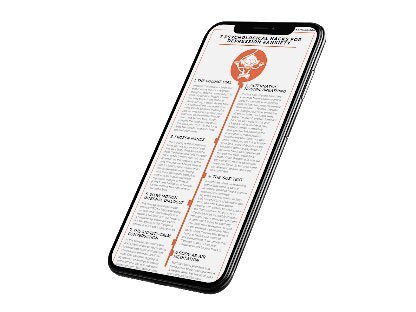
7 Hacks for “Monkey Mind Calm” Cheat Sheet
Having control over your mind is possible, peace of mind is possible, and mental clarity, calm, and focus are all within your reach.
To learn how, all you have to do is scroll up, hit play and discover:
The difference between real change as compared to our expectations of change
Authentic self-help versus spirituality junk and the spiritual junkies it creates
The importance of self-inquiry to discover both who you are and who you aren’t
How a “hyper-egoic” consciousness due to social media can be detrimental to quieting the self-referential mind
The benefits of finding a balance between goals and the karma yoga idea of letting go of outcomes
Ben’s Pyramid of Self, a relationship between ego, narratives about yourself, your biology, and higher cause
How the ego can provide a false sense of being bulletproof, and the drawbacks to such an attitude
Why we should always be skeptical, or critical of gurus as the end all, be all to answering life’s big questions
The human condition of coping (or not) with uncertainties
How freedom and individual sovereignty are related and how to achieve them
How meditation brings a needed silence that doesn’t come to the body naturally
Further Resources on the Web, This Podcast, and the MMM Blog:
Ben’s guided meditations on InsightTimer
Walking Meditation: 3 Memory Improving Ways to Walk Yourself Into Bliss
How to Improve Concentration and Memory Buddha Style
The Wise Advocate: Become A Better Leader of Your Memory
How to Stop Punishing Yourself When You Say Stupid Things
The post An Abundance Of Powerful “Monkey Mind” Meditation Tips with Ben Fishel appeared first on Magnetic Memory Method - How to Memorize With A Memory Palace.
April 25, 2019
Katie Kermode On Memory Competition and Casual, Everyday Mnemonics
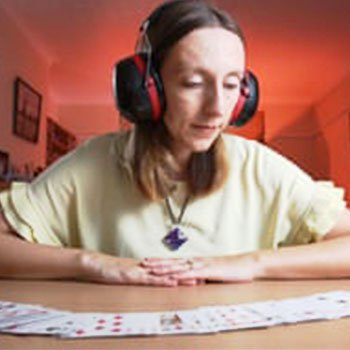 Do you ever wonder how memory competitors get so good at their craft?
Do you ever wonder how memory competitors get so good at their craft?
Do they have some secret method that the Average Joe can’t begin to comprehend?
Is there a memory secret society that’s only available to those who participate in the competition world that you and I would never be able to access?
Good news:
Memory competitors are just like you. They have their strengths, weakness, and, believe it or not, have the time to have a life outside of memory training!
On today’s episode of the Magnetic Memory Method Podcast, I sit down with Katie Kermode, a memory champion and competitor from the United Kingdom, to discuss her memory journey.
Competing for over two decades, Katie is ranked 16th place in the world for memory competitors and is a four time memory world record holder.

She is also a professional translator and proofreader, memory coach, and is the creator of memorization and recall software used at the IAM World Memory Championships in 2018.
If you are struggling with finding the time to devote to memory training…
If names or dates elude you in information memorization…
Or if you think the end all, be all to strengthening your memory is a memory system just out of reach for the everyday memory improvement enthusiast…
This podcast is for you.
Click play above now and discover:
The “right” age to begin memory techniques with children and how to motivate them to use these techniques from a young age
How to make the most of limited time for memory training
Using natural association patterns to
Variances in techniques from memory competitors to casual users of mnemonics (and why there is no singular approach to memory training that is “best”)
Having a memory system vs. memory principles to build your own method
The benefits of memory software for memorization and recall
How to revolutionize attitudes about memory training in the digital age (without developing Digital Amnesia)
Memorization in competitions versus real life application
The benefits of attaching information to people along a Memory Palace journey

Further Resources on the Web, This Podcast, and the MMM Blog:
– Katie Kermode’s Official Website
– Katie Kermode on Nelson Dellis’s Mind Show
– The International Association of Memory
– Next Level Memory Training Secrets with USA Memory Champion John Graham
– Nelson Dellis on the Magnetic Memory Method Podcast (episode referenced in this one)
– Idriz Zogaj’s Discussion on Memory Training Apps
Stats about Katie (Records and Memory Titles):
World Record in 5-minute Names (105)
World Record in 15-minute Names (224)
World Record in 15-minute Words (318)
World Record in Memory League Words (50 in 51.31 seconds)
MSO Memory Champion 2018
MSO Memory Champion 2017
UK Memory League Champion 2016
UK Memory Champion 2012
About Katie’s Software:
This memory training software features these competition formats:
National Standard
International Standard
World Championship Standard
Includes free memory training across these memory disciplines:
numbers
names
5 minute words
dates
cards
images
binary
The post Katie Kermode On Memory Competition and Casual, Everyday Mnemonics appeared first on Magnetic Memory Method - How to Memorize With A Memory Palace.
April 18, 2019
Flashbulb Memory: When, Why And How Vivid Recall Seizes Your Mind
 Do you have a “flashbulb memory“?
Do you have a “flashbulb memory“?
Here’s a simple memory test:
Do you remember where you were and what you were doing during the 9/11 attacks?
If so, in how much detail… exactly?
After all, 9/11 was one of the most mentally impacting world events millions of people not only remember. They remember it vividly.
What does vivid mean in this context?
For example, you might recall exactly what activity you were performing when you learned about the attack. Myself, I was in Stong College on the York University campus, just before a class.
It’s an irrelevant detail in the overall scope of my life, but the fact that I remember so much minutia is precisely the point.
For example, I was in the cafeteria reading that morning. My phone rang and my friend Andrew said, “Find a TV.”
I remember it vividly, down to the fact that my eyes traced the sky through the window and instantly fell upon an airplane.
But here’s the problem:
This memory I have about seeing an airplane through the window might not be accurate.
In fact, chances are that it’s a flashbulb memory. Just like the time I spent with Tony Buzan, which we’ll talk about in a minute.
But before we define this concept and talk about some powerful memory exercises, let’s look at the history of this term:
Flashbulb Memory Defined
The term flashbulb memory refers to a long lasting vivid memory of the circumstance around the time of receiving a shocking or surprising piece of news or event.
Coined as a metaphor in the 1970s, it refers to the feeling of mentally capturing a complete scene in a single moment.
But more than just feeling like you‘ve taken a mental snapshot, the idea is that your mental image includes a ton of information. I‘m talking about everything from the most crucial details to the most mundane ones.
Even more:
It’s the feeling that the memory will last indefinitely, almost as if it were a photograph.
These memories have intrigued memory researchers for decades. Some consider flashbulb memory as a kind of autobiographical memory, which is the recollection of events you have personally experienced.
Typically, individuals involved as subjects in memory studies feel extremely confident about their recollections of events like 9/11.
However, in reality, researchers find that flashbulb memories are mostly haphazard and incomplete.
Why? Because many factors affect your memory. These may include:
Shock
The personal importance you place on the event
Emotional states
Surrounding objects
People in the environment
Locations
Activities at the time
These factors and more condition the subsequent ways you might experience flashbulb memories.

Why People Encode Memories “In A Flash”
When your brain experiences something traumatic, it often establishes a sharp mental image of that particular event.
Keep in mind that “mental imagery” is not necessarily visual. Yet, many people do describe being able to re-envision detailed information. It’s almost as if their memory of an event is like photograph.
When you consider the kinds of things that become flashbulb memories, our brains usually base them on traumatic events.
More often than not, they are public events.
This tendency means that people around also us experienced the events. As a result, they wind up being discussed often.
You not only experience such events via television or on the Internet, but you re-experience them multiple times while talking about them in multiple places with multiple people.
Of course, not all such memories involve tragedy.
Some other examples of flashbulb memories might include the birth of your child, college graduation, or getting your first job. These events might stand out as monumental events or milestones in your life.
For example, meeting Tony Buzan is a personal example from the world of memory training.

The reason why is that I was so overwhelmed by many emotions, especially given the personal attention he paid to me.
But that doesn’t mean my memories of the time we spent together are accurate. Far from it!
A Quick and Simple Memory Exercise
Have you ever met someone famous who touched your life?
Go ahead and think it through.
Even if you just saw them from a distance, take note of the memory and describe it.
Then think more about the memory. Think about all the times you told the story to others. You’ll probably have experienced it multiple times.
When it comes to celebrity encounters and historical events, you almost always discuss them multiple times with different people in a variety of locations.

I have another flashbulb memory from working with celebrities Dominic Purcell, Edward Furlong and director Uwe Boll
The conclusion is therefore simple:
If flashbulb memories like these have the tendency to last for life, it is because our sharing behaviors ingrain them in our minds.
The Truth About Flashbulb Memory
Aside from being referred as a type of autobiographical memory, many researchers now believe these memories are prone to many fallacies and errors.
Why?
As mentioned, our feelings, emotions, and multiple repetitions change the actual accounts of the events in memory.
As much as we would like to think that our memories regarding numerous events are accurate and foolproof, multiple studies show the opposite. We now know that flashbulb memories alter with time as we go through more life experiences.
As memory expert Stephen Kosslyn has shown in The Case for Mental Imagery, the locations of or memories also change location in the brain.
Therefore, recollections that might appear certain, vivid and clear have almost certainly been “tainted” by external occurrences and factors.
Don’t worry. As we’ll see, this fact is not necessarily a bad thing when it comes to memory improvement training.
Flashbulb Memory Vs. Eidetic Memory
Consider the following study:
Researchers asked 54 undergraduate students to record their memory regarding the 9/11 attacks.
They asked how and where participants learned about the attack, what were they doing and if they were with someone when they heard the news.

This is not the “eidetic memory” image most people have of 9/11. What’s yours?
The scientists also asked about how clearly participants could envision their memories. They wanted to know just how certain people were about their recollections being accurate.
Next, they asked the participants the same questions about other memorable events.
Time Changes Your Memory!
Finally, the researchers compared how ordinary memories and flashbulb memories change over time.
To do this, they asked the same questions after one week, one month and then following seven months.
The researchers concluded that, while the ordinary memory and flashbulb memory were consistent for a week, the passing of time significantly reduced consistency.
Strangely, participants believed that their flashbulb memory was more accurate as compared to their ordinary memory.
In fact, some people even believed that they were experiencing eidetic memory (often called photographic memory).
Eidetic memory refers to an individual’s ability to vividly recall information from memory with minimal exposure and without using any mnemonic devices.
Whereas some people use the terms photographic memory and eidetic memory interchangeably, they can be distinguished.

Eidetic memory is the ability to view an image for a few minutes and then recall it with detailed precision. Photographic memory on the other hand, is the mythical ability to recall text or numbers in great detail.
To be clear:
Eidetic memory seems to be real. Photographic memory, on the other hand, has not been found to actually exist, at least not in humans.
Moreover, while flashbulb memories are often inaccurate, some studies have found that eidetic memories can be accurate.
Can You Really Enhance Your Eidetic Memory?
Even though eidetic memory is rare among individuals, you can try to enhance it, or at least boost your overall memory through various memory improvement exercises. Here are the three main techniques that might help in enhancing your memory:
The Memory Palace
The Memory Palace is a mental recreation of a familiar building or place. The main aim of the Memory Palace is to assist your ability to retain important information by placing symbols in a sequence in that imaginary building. I call these symbols “Magnetic Imagery” and each image is built from the “Magnetic Modes.” There are many terms for the Memory Palace technique, ranging from:
Roman Room
Method of Loci
Journey Method
Mind Palace
…and many more that essentially describe “location-based mnemonics.” Overall, there are more similarities than differences, so please don‘t get hung up on the terminology.
As one of the greatest memory exercises ever invented, the Memory Palace lets you leave behind information you want to remember in specific areas of the mental building through a process of association.
For instance, you will use familiar rooms or objects you can easily link to the target information. The technique works because it transforms semantic information into a sequence of images, primarily by tapping into your episodic memory.
All of this happens while you also associate both the target information and the mental imagery to a physical location. In other words, you are tapping into spatial memory as well.
There are numerous Memory Palace exercises that can help you in boosting your memory. I suggest you experiment with as many as you can.
The Memory Peg
The Memory Peg technique is like the Memory Palace. This technique includes a two-stage method.
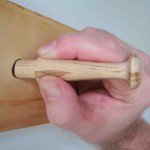
The first stage involves learning a standard set of peg words that are typically 10 number-rhyme pairs.
The second stage includes visualizing the information you want to remember and linking it with the rhyming word. Memory expert Bruno Furst was a major proponent of this technique.
Memory Boosting Brain Exercise
These exercises can potentially help in improving your eidetic memory. Or you can try following these steps:
Closing your eyes and imagine that you are looking at a famous painting. It might be the Mona Lisa or Girl with the Pearl Earring.
Focus on what happens in your mind when you imagine this painting.
Ask yourself: Do you really need to picture every small detail to get a clear impression? In most of the memory training exercises, visualization is actually not necessary.
Next, I want you to shift gears. Focus on the last conversation you held with someone.
Start filling in the details of that conversation in your mind. Think of the phrases you used, the words, the features of that person, as well as the location and any other details you can bring to mind.
Observe how your memory works and changes as you complete the exercise.
Perform this same exercise with a piece of music.
You will soon realize that the whole notion of eidetic memory really doesn’t matter. Nor should attaining an eidetic memory definition be your goal.
What matters most is that you exercise your recall abilities and explore what “vivid memory” means to you. You don’t need eidetic memory or anything else if you just focus on exercising your memory as you experience it.
Memory expert Gary Small has even more memory tips that will help you prove it for yourself. Or you can just get this free memory course:
Context Is The Key
In sum, flashbulb memories are usually tied to monumental events and historical milestones. But these aren’t what create them. They are generally created when events come loaded with a certain emotional or personal link that leads to multiple exposures over time.
This combination of events plus repetition in multiple contexts makes them stand out from the mundane features of everyday life. Flashbulb memory has as much to do with your perception of the world and your social setting following events as it does with memory.
For example, if I had met Tony Buzan, but had no interest in memory or people to speak about memory week after week, it is quite likely that I would not experience a flashbulb memory every time I hear his name.
The depth of memory comes from multiple contexts that naturally involve repetition. And the emotional nature of the meeting must be kept in mind when thinking about how accurate I remember it. Luckily, I kept in touch with Tony via and was honored to review his book, Mind Map Mastery.
If you want to keep accurate details of the major events and milestones of your life, try this:
Instead of focusing on forming eidetic memory or photographic memory, take up the memory exercises we teach on the Magnetic Memory Method blog, vlog and podcast.
Doing so will increase the likelihood of enjoying a more accurate memory that helps you easily recall more information throughout your life. All without worrying when your memory has altered with passing of time.
It will, and that’s not a bad thing at all.
The post Flashbulb Memory: When, Why And How Vivid Recall Seizes Your Mind appeared first on Magnetic Memory Method - How to Memorize With A Memory Palace.
April 11, 2019
The Dominic System: What It Is And Why People Love It
 Dominic O’Brien suffered from ADD and dyslexia.
Dominic O’Brien suffered from ADD and dyslexia.
But that didn’t stop him from winning the World Memory Championships… not once but eight times.
Memory accomplishments like these are not very common!
Even less common is going on to develop a memory system that changes the entire world.
Where does this ingenious system come from?
O’Brien developed the Dominic System after getting inspired by watching Creighton Carvello memorize a card deck on television.
O’Brien’s innovative mnemonic system has since become popular because of how it allows people to utilize their minds for accomplishing outstanding feats.
As a result, O’Brien is considered one of the world’s foremost memory experts. He has been reaching individuals, and helping them utilize their memories through his various books and training programs, for decades.
What is the Dominic System?
A mnemonic system, the Dominic System is utilized for remembering sequences of numbers that are similar to the mnemonic major system.
O’Brien built his approach on a core arrangement we usually call the Major System. You’ll learn more about that in a minute.
All such systems work by helping people associate numbers with something else. And a core innovation Dominic O’Brien brought to the game was focusing on individuals in place of objects. He changed this focus because individuals are much easier to remember than objects.
In this system, sometimes called “Hotel Dominic,” the mnemonist (i.e. you) converts numbers into letters. These letters are utilized to create people’s initials. Each individual’s name is then linked to an action.
How is it Different from the Major System?
The Major System is usually ideal for basing words on numbers linked to consonants. Like this:
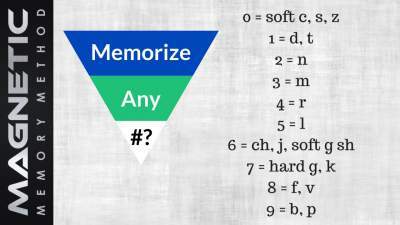
For instance, the number 12 might be ‘tin’, which is not easy to remember than ‘Al Bundy’. The number 84 could be ‘fire’ which means the sequence 1284 would mean ‘a tin on fire’.
Of course, one perceived weakness of the Major is that it only lets you encode two-digit numbers.
This is actually not a problem. For example, you can combine the Major with a number shape system, as I’ve done here with 358:

A Major System Mnemonic Example for the number 358
In this example, a famous mailman is shoving the mail into a snowman. (In the Major, 35 suggests the word “mail” and 8 looks like a snowman.)
Notice that I am using a very specific mailman. (Let me know in the comments if you recognize him.)
Why?
Because the brain is much more likely to react to the increased level of specificity. That’s why I suggest you always selecting characters to link with a number on the basis of familiarity no matter what system you use.
Is It Worth The Time?
True, covering 00–99 with familiar characters and names will require effort and time.
But it will be worth it! Having any kind of system will help you save the struggle and time in the future when you want to remember a sequence of numbers. Numbers like:
Bank accounts
Credit card numbers
Insurance numbers
Birthdates of family members
Emergency numbers
Numbers involved in programming
Historical dates
Applications in memorizing music
Tools for learning numbers in foreign languages with greater ease
Simply put, it only makes sense to learn a number system.
But it’s worth repeating:
Be specific.
The mnemonic imagery of many beginners can be bland and abstract.
Avoid this mistake.
Boring imagery makes it too complex to exaggerate. That’s the major reason people struggle.
Why is such imagery so difficult?
The answer is simple:
It is not easy to associate an abstract idea with a vague image in a sequence. (Unless you have these visualization exercises.)
For instance “a pen fights with a bottle” will never be as memorable as “Thor fights with George Bush.”

Mnemonic Example of the Dominic System with Thor and George Bush
When utilizing specific individuals, your brain has the ability to visualize them in a more effective way. You can further enhance your ability of getting a mental image with the memory systems by performing visualization exercises.
The emphasis O’Brien placed on being specific when selecting the character has helped many people. memorize longer sequences of numbers.
However, this point is important:
This Is A P.A. System, Not A P.A.O. (Person Action Object) System
The Dominic System is a Person-Action system. If you want to learn a full P.A.O. please watch this video about creating your first P.A.O. list:
How Does The Dominic System Work?
In the Dominic system, you have to break long numbers into two digits. Each pair of digits represents an individual doing a certain action. The numbers are converted into letters for number by utilizing the rules mentioned below for easy remembrance:
The digit 0 is O
Initial five digits (1 – 5) become the initial five alphabets (A –E)
The digit 6 is S due to similar sounds
The digits 7 and 8 becomes G and H
The digit 9 becomes N due to similar sounds
With a little effort, you will be able to learn these substitutions, making it easier to learn this system. Here it is visualized
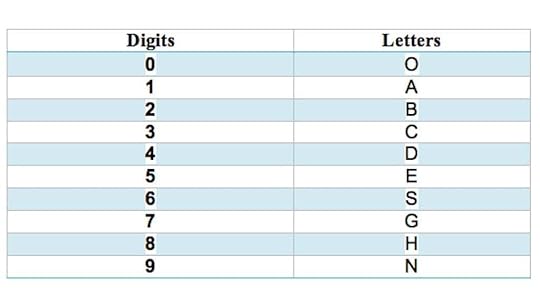
When you memorize this table, go on to learn the next step.
Determining Names for Digit Pairs
Start by noting down the numbers from 0 all the way to 99. Review all these numbers and mentally translate them into Dominic letters. Notice if any initials are suggesting anything. For instance, the digits 20 become BO. It might suggest a Buddhist meditating under a Bo tree. It might suggest something else to you.
Typically, the pairs have no associations or meetings. However, there are some exceptions.
For example, 07 can be associated with James Bond, 13 can be associated with bad luck, 100 can be associated with a century, 16 can be associated with sweet sixteenth birthday, and so on.
Always utilize whatever the first link is formed in your mind when you look at the pairs as this will be the most effective way to continue this system.
Assigning Actions to Names
The character you select must also have an associated action, which is unique throughout your list of 100 names. Therefore, if you have utilized Serena Williams for 60 then avoiding using Andre Agassi for 11. Since for both you will associate playing tennis as an action.
The Dominic system distinguishes actions from characters in order to remember longer numbers. Therefore, the action you select must be “performable” by other selected characters. Therefore, select the actions that are obvious and distinctive for an individual.
How Do You Make This Memory System Work?
In order to make this system work for you, it is best to create the list of names with a mixture of celebrities, your friends and family members.
There would be certain letters that will give obvious solutions. For instance “Ho” suggests Santa Claus riding his sleigh.
If you get stuck thinking of characters and associated actions, you can look at sample lists for ideas.
However, keep in mind that it is better to create your own names and associations. Copying someone else’s list would be difficult for you to remember, unless the list includes famous characters and associated actions that you are pretty familiar with.
Here is a list of possible characters you could create using this technique:
00 (Olive Oyl) – going on a date with Popeye
22 (Bugs Bunny) – stealing a carrot
86 (Hans Solo) – on his spacecraft
You can assign names to each digit and then associate a relatable action to help you remember.
For more, check out the 3 Most Powerful Memory Techniques for Memorizing Numbers.
Memorizing Two Digits
So, if you want to remember the house number of your friend which is 86, all you have to do is imagine Hans Solo piloting his spacecraft to your friend’s apartment’s roof. It crashes on the roof or laser cannons are being shot to save the people from an alien invasion. This will make it rather easy for you to remember the house number.
Memorizing Three Digits
You can easily memorize three digits by linking the image you have created for the initial two digits with the shape or rhyme of the third digit. For instance, 244 could be something like Bugs Bunny stealing a carrot. For the action, Bug could be running away using a boat! Just imagine the glee on Bugs Bunny’s face as he successfully sails his boat with a carrot in his mouth.
Memorizing Four Digits
You can memorize four digits by simply splitting the numbers in pairs. Utilize the image of the character you have assigned to the first digit with the associated action for the second digit. For instance, if you want to memorize the sequence 8042 (Santa Clause) and (David Beckham), you can picture Santa Clause trying to help David Beckham score the winning goal!
Memorizing Longer Numbers
Memorizing longer numbers is easy too since you can simply break them down into pairs and a single digit, if any is left over. You can utilize a sequence of a character, associated action, character action, and then form a story through these images in mind.
For instance, you want to remember a café’s phone number 68221656. There here: 68 will be Sherlock Holmes, 22 (action) will be Olive Oyl (dating), 16 will be Arnold Schwarzenegger, and 56 (action) will be Scissorhands (cutting bushes).
You can now form a story with these images that can be linked to the phone number of the café. For instance, Sherlock Holmes is sitting in a restaurant dating Olive Oyl and Arnold Schwarzenegger enters the café with Edward Scissorhands and starts cutting off the plants in the café.
Who wouldn’t remember such a story?
Pitfalls You Must Avoid
Believe it or not, people search the internet for a Dominic system generator.
But that’s not the real skill here.
The skill is to use the system to match what you already have in your memory with a phonetic number system that allows you to translate numbers into letters.
Put in the work and you will receive the benefits. Otherwise, you risk deskilling your creativity and locking yourself outside of the very same skill you’re trying to develop.
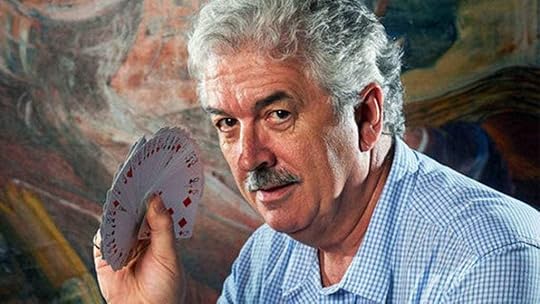
Dominic O’Brien about to memorize a deck of playing cards
Memorizing a Deck of Cards
While the Dominic system is utilized to memorize longer numbers, you can also use it for remembering other sequences like deck of cards.
This works by systematically associating numbers with cards.
For instance, if you associate the nine of clubs with 39 then you can associate Chuck Norris (3+9) in a story where he is using 9♣ in an active way.
This is definitely a powerful memory technique that you can use to your advantage if you have any of these 13 reasons to memorize cards.
But of course, you will have to invest a good deal of time and effort to prepare the sequence beforehand to fully benefit from the Dominic system.
It might be the right memory system for you, however, so get some training materials and learn how to complete a memory course with these tips.
Should You Use The Dominic System or The Major System?
Now that you know the difference, you have more insight that will help you choose.
But, at the end of the day, it’s entirely up to you.
I personally find the Major a more direct method of creating relationships between numbers and letters that leads to more solid word and image creation.
Yet, I’ve heard from many people who absolutely love the Dominic System. Some people are even able to use O’Brien’s images without creating any of their own. David Thomas is one example I’ve heard from. He broke the Guinness World Record for memorizing Pi in 1998 (22,500 digits) using “Hotel Dominic” virtually unchanged.
That is not only utterly amazing.
It’s also a demonstration of just how powerful O’Brien’s contribution to the art, craft and science of memory improvement this number memorization system has been.
Recommended Readings
O’Brien, Dominic. (1994). How to Develop a Perfect Memory. Trafalgar Square
O’Brien, Dominic. (2000). Learn to Remember : Practical Techniques and Exercises to Improve Your Memory. Chronicle Books
O’Brien, Dominic. (2003). How to pass exams. England: Duncan Baird Publishers.
O’Brien, Dominic. (2014). How to Develop a Brilliant Memory Week by Week: 50 Proven Ways to Enhance Your Memory Skills. Watkins Publishing
O’Brien, Dominic. (2016). You Can Have an Amazing Memory: Learn Life-Changing Techniques and Tips from the Memory Maestro. Watkins Publishing
The post The Dominic System: What It Is And Why People Love It appeared first on Magnetic Memory Method - How to Memorize With A Memory Palace.




